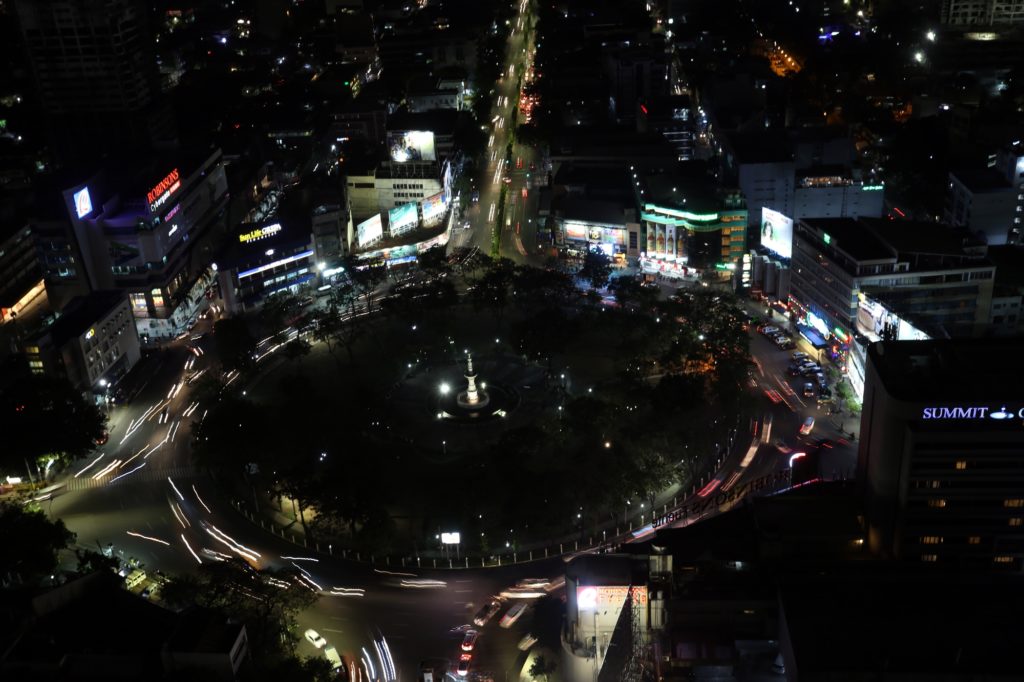Synchronized Traffic Laws in Cebu Province

FUENTE OSMEÑA BY NIGHT IS BRT ROUTE: An areal view of Fuente Osmeña rotunda during night time. This area is part of the Bus Rapid Transit (BRT) route.(CDN PHOTO/JUNJIE MENDOZA)
FOR almost 15 years, 42-year-old Vincent Hermosilla travels from his home in Danao City to his workplace at Cebu Port Authority (CPA) in Cebu City daily.
To cover the 43.5 kms distance from Danao located, Hermosilla has to drive at least an hour passing through three northern municipalities namely: Compostela, Liloan, and Consolacion; and the city of Mandaue.
Because Hermosilla wants to avoid traffic, he now has to leave his house an hour earlier than before.
“Sa una, mogikan kog 6:30 a.m. para sa akong duty nga alas otso. Karon kay dapat mosayo na ko og gikan mga 5:30 kay basin maabtan ko og grabeng traffic (Before, I would leave at 6:30 a.m. for my work that starts at eight.
Now, I have to leave as early as 5:30 because I might get stuck in heavy traffic),” said Hermosilla.
He said that traffic has become very bad lately.
The Cebu provincial government is now in the process of drawing up a synchronized traffic plan that will help solve the road congestion in Cebu province, especially in Metro Cebu areas.
Metro Cebu is composed of the cities: Cebu, Mandaue, Lapu-Lapu, Carcar, Naga, Talisay and Danao; and the municipalities of San Fernando, Minglanilla, Cordova, Consolacion, Liloan and Compostela.
Through the creation of the Inter-Agency Council on Traffic (I-ACT) Cebu, a unified traffic solution will be implemented in the province.
“This is one way to control traffic congestion — a plan to have a unified traffic ordinance in the whole Cebu province,” said Capitol’s focal person on traffic management, Jonathan Joy Tumulak in Cebuano.
“We really need everyone’s participation that is why I-ACT was created is to make every LGU understand the problem of traffic,” he added.
I-ACT is headed by Cebu Gov. Hilario Davide III while its members include the regional directors of the Department of Public Works and Highways (DPWH), Land Transportation Office (LTO), Land Transportation Franchising and Regulatory Board (LTFRB), Philippine National Police Provincial Command and Cebu Highway Patrol Group (HPG).
Representatives from the Department of Education (DepEd), the Archdiocese of Cebu, Cebu Chamber of Commerce and Industry (CCCI), Mega Cebu Development and Coordinating Board (MCDCB) also assist the council.
According to Tumulak, the Archdiocese of Cebu, for example, plays an important role in the regulation of religious activities and funeral processions that utilize national road and can cause traffic.
To enforce combined traffic laws in municipalities and cities of Metro Cebu, local chief executives play a vital role in I-ACT Cebu.
The Council will have its first meeting to unify the traffic ordinances of the different cities and towns.
“We will compare and consolidate the different ordinances and once we have done that, we will craft the traffic code for the entire province of Cebu,” Tumulak added.
With the creation of I-ACT, Tumulak hoped to see a difference in the traffic scenario.
“After five years, while we expect more vehicles on the road and an increased population, at least traffic won’t be as bad,” he said.
Disclaimer: The comments uploaded on this site do not necessarily represent or reflect the views of management and owner of Cebudailynews. We reserve the right to exclude comments that we deem to be inconsistent with our editorial standards.
